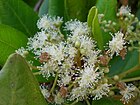Note: This is a project under development. The articles on this wiki are just being initiated and broadly incomplete. You can Help creating new pages.
Pimenta dioica
Pimenta dioica is the dried unripe berry of
Pimenta dioica. It is a midcanopy tree native to the Greater Antilles, southern Mexico, and Central America, now cultivated in many warm parts of the world.
==Uses==https://ayurwiki.org/Ayurwiki/Pilocarpus_microphyllus Menstrual cramps, Abdominal pain in Caribbean culture, Cardiovascular effects.
Contents
- 1 Parts Used
- 2 Chemical Composition
- 3 Common names
- 4 Properties
- 5 Habit
- 6 Identification
- 7 List of Ayurvedic medicine in which the herb is used
- 8 Where to get the saplings
- 9 Mode of Propagation
- 10 How to plant/cultivate
- 11 Commonly seen growing in areas
- 12 Photo Gallery
- 13 References
- 14 External Links
Parts Used
Chemical Composition
The leaf oil of Pimenta dioica L. of Cuban origin has been analyzed by a combination of capillary gas chromatography and GC/MS. The oil contained more than fifty components, of which more than forty have been identified. The main constituent found was eugenol. [1]
Common names
| Language | Common name |
|---|---|
| Kannada | |
| Hindi | |
| Malayalam | |
| Tamil | |
| Telugu | |
| Marathi | NA |
| Gujarathi | NA |
| Punjabi | NA |
| Kashmiri | NA |
| Sanskrit | |
| English | Allspice |
Properties
Reference: Dravya - Substance, Rasa - Taste, Guna - Qualities, Veerya - Potency, Vipaka - Post-digesion effect, Karma - Pharmacological activity, Prabhava - Therepeutics.
Dravya
Rasa
Guna
Veerya
Vipaka
Karma
Prabhava
Habit
Identification
Leaf
| Kind | Shape | Feature |
|---|---|---|
| Simple | Round in outline | Leaves are 6-15 cm long, 3-6 cm wide and aromatic when crushed. They are dark green on the upper surface and lighter green beneath. |
Flower
| Type | Size | Color and composition | Stamen | More information |
|---|---|---|---|---|
| Bisexual | White | Flower branches 5-15 cm long. |
Fruit
| Type | Size | Mass | Appearance | Seeds | More information |
|---|---|---|---|---|---|
| Simple Fruit | Round | 4-6 mm in diameter | Deep purple to black | {{{6}}} |
Other features
List of Ayurvedic medicine in which the herb is used
Where to get the saplings
Mode of Propagation
How to plant/cultivate
A plant of the moist to wet lowland tropics, growing best at elevations below 330 metres but able to be grown up to 1,500 metres.[3]
Commonly seen growing in areas
Photo Gallery
References
External Links
- Ayurvedic Herbs known to be helpful to treat Menstrual cramps
- Ayurvedic Herbs known to be helpful to treat Abdominal pain in Caribbean culture
- Ayurvedic Herbs known to be helpful to treat Cardiovascular effects
- Herbs with Flower used in medicine
- Herbs with Leaves used in medicine
- Herbs with common name in English
- Habit - Tree
- Index of Plants which can be propagated by Seeds
- Herbs that are commonly seen in the region of Tropical area
- Herbs
- Myrtaceae



